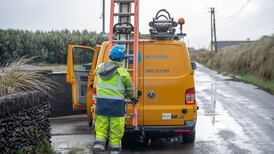The United States presidential campaign still has three ugly months to go, but the odds – 83 per cent odds, according to the New York Times model – are that it will end with the election of a sane, sensible president. So what should she do to boost the US's economy, which is doing better than most of the world but is still falling far short of where it should be?
There are, of course, many ways the US economic policy could be improved. But the most important thing we need is sharply increased public investment in everything from energy to transportation to wastewater treatment.
How should we pay for this investment? We shouldn’t – not now, or any time soon. Right now there is an overwhelming case for more government borrowing.
Let me walk through this case, then address some of the usual objections.
Aging infrastructure
First, we have obvious, pressing needs for public investment in many areas. In Washington DC, the aging metro is in such bad shape that whole lines may have to be shut down for maintenance. In Florida, green slime infests beaches, in large part because failure to upgrade an 80-year-old dike or to purchase more land as a runoff area is forcing the army corps of engineers to release polluted water from Lake Okeechobee. There are similar stories all across the US.
So investing more in infrastructure would clearly make us richer. Meanwhile, the federal government can borrow at incredibly low interest rates: 10-year, inflation-protected bonds yielded just 0.09 percent last Friday.
Put these two facts together – big needs for public investment, and very low interest rates – and it suggests not just that we should be borrowing to invest, but that this investment might well pay for itself even in purely fiscal terms. How so? Spending more now would mean a bigger economy later, which would mean more tax revenue. This additional revenue would probably be larger than any rise in future interest payments.
And this analysis doesn’t even take into account the potential role of public investment in job creation: despite a low headline unemployment rate, the US economy is still probably short of full employment, and an investment agenda would also offer valuable insurance against possible future downturns.
Objections
So why aren’t we borrowing and investing? Here are some of the usual objections, and why they’re wrong.
We can’t borrow because we already have too much debt.
People who say this usually like to cite big numbers – “Our debt is $19 trillion,” they intone in their best Dr Evil voice. But everything about the US economy is huge, and what matters is the comparison between the cost of servicing our debt and our ability to pay. And federal interest payments are only 1.3 per cent of GDP, low by historical standards.
Borrowing costs may be low now, but they might rise.
Yes, maybe. But we’re talking about long-term borrowing that locks in today’s low rates. If 10 years isn’t long enough for you, how about 30-year, inflation-protected bonds? They’re yielding only 0.64 per cent.
The US government can't do anything right. Solyndra! Benghazi!
A large part of our political class is committed to the proposition that any and all government efforts to improve our lives are doomed to failure – a proposition that turns into a self-fulfilling prophecy when these people are actually in office. But to hold that view you have to turn your back on our own history: American greatness was in large part created by government investment or private investment shaped by public support, from the Erie Canal to the transcontinental railroads to the interstate highway system.
Renewable energy
As for the constant harping on individual failures, all large organisations, private businesses very much included, engage in some projects that don’t work out. Yes, some renewable-energy investments went bad – but overall, the Obama administration’s promotion of solar and wind has been a huge success, with a rough quadrupling of production since 2008. Green energy should be seen as an inspiration, not a cautionary tale.
There is, in short, an overwhelming policy case for federal borrowing to pay for public investment. But will the next president be able to act on this case?
The good news is that elite discourse seems, finally, to be moving in the right direction. Five years ago the Beltway crowd was fixated on debt and deficits as the great evils. Today, not so much.
The bad news is that even if Hillary Clinton wins, she may well face the same kind of scorched-earth Republican opposition President Barack Obama faced from day one. So it matters not just who wins in November, but by how much. Will there be a strong enough Democratic wave to give Clinton the ability to act?
But while the politics remain uncertain, it's clear what we should be doing. It's time for the federal government to borrow and invest. – (2016 New York Times News Service)













